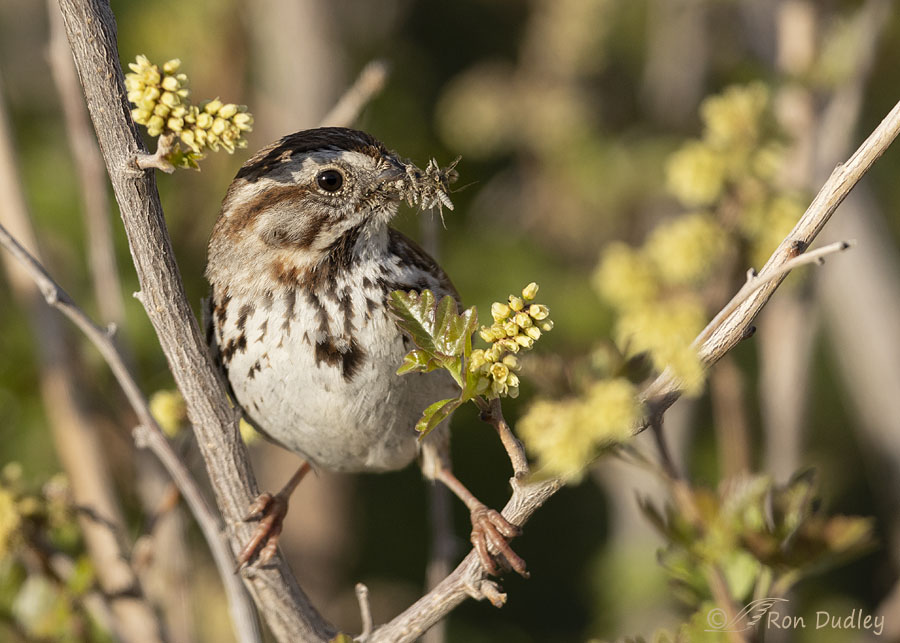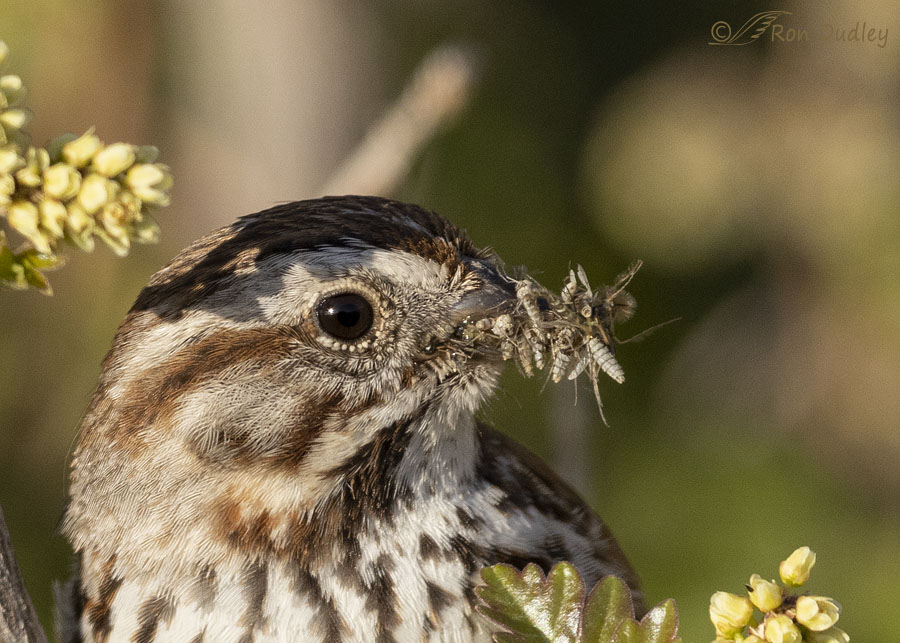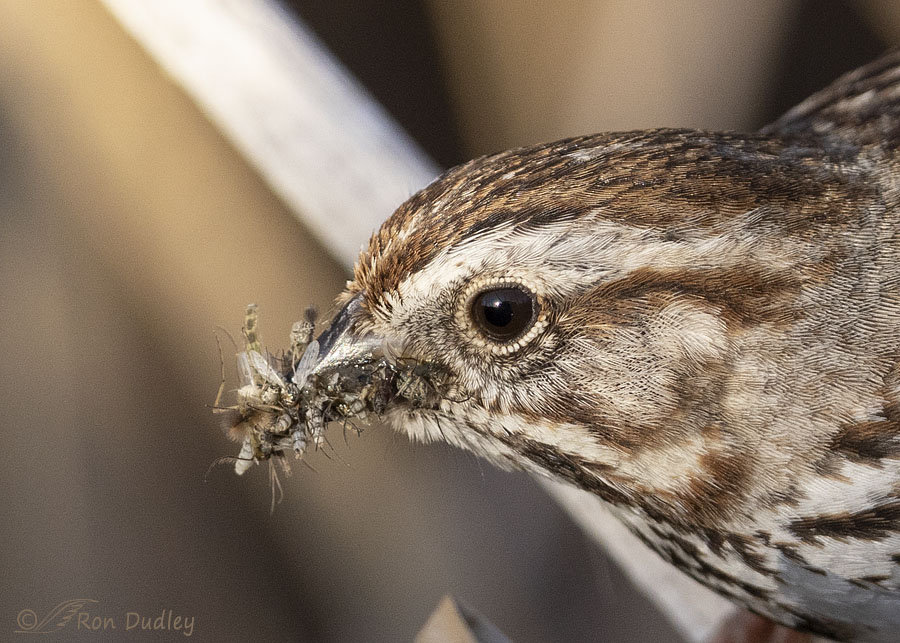How do they do that?

1/2500, f/6.3, ISO 800, Canon R5, Canon EF500mm f/4L IS II USM + 1.4 tc, not baited, set up or called in
Yesterday morning near Great Salt Lake I spent nearly four minutes watching this Song Sparrow as ‘she’ stuffed her bill with insects to feed her babies. Her hunting technique was methodical as she moved from perch to perch, spending time at each one as she searched for more victims. And she was finding them too. Usually she was picking them off of the small branches where they were resting.
I simply cannot figure out how birds manage to gather more insects when their bill is already full with them, without dropping the bugs they already have in their bill or letting some of them escape. Lots of birds do it with their preferred prey, puffins with fish, sapsuckers with ants and meadowlarks with worms come to mind, but many others do it too. But how they do it is a mystery to me.

As far as I can tell, every last one of her victims was a midge. No prey diversification here. The inside of my pickup was buzzing with both midges and mosquitoes (to the point that I had to douse myself with spray for the skeeters, midges don’t bite or sting) but she either preferred midges, or mosquitoes weren’t landing on the branches where she had easy access to them.

In case you’re wondering, the left side of her bill was nearly as full of midges as her right side. I never once saw her drop any of them and I was watching for it too.
Dang, I’m glad to see a resurgence of midges near the lake after several years mostly without them because of the drought and disappearing lake. I hope it isn’t just temporary.
Ron


Fascinating photos, comments, and speculations. I’m a velcro voter. Also, I admire the sparrow’s clever wide-legged stance in the first picture.
Frances, I’m glad you pointed her stance out because I like it too. I get similar postures with blackbirds and wrens most often.
Thank you (and Dan) for sharing this mystery. Amazing detail in the shot too.
As others have said, I cannot manage even smaller mouthfuls without spills. Colour me awed and impressed. Again.
Thanks, EC. Dan’s a valuable contributor to FP.
It’s a mystery, alright, and these photos (and her carrying capacity) are just amazing! Lyle noted the eye-ring detail — she’s better at that, too, than any makeup artist! 😎
Chris, I thought it was interesting when I learned that eye rings are made up of tiny, tiny feathers.
Some of the midges don’t even seem to be IN her beak, their bodies just kind of stacked on top of each other. So does that mean she’s just holding onto them by a wing or a leg? You watched her for 4 minutes – did she then fly off towards her nest? So much work! Thank you for documenting it. Amazing!
And thanks to Dan Gleason for the description of how their beaks work with the seeds!
Carolyn, I think she’s holding on to the legs of many of them. I have no idea where her nest is.
That is amazing. And so are those photos!
Thank you, Michael.
Birds make us wonder and often leave us with mysteries to solve. For me, this is one of them. I wish I had a good answer but I don’t. But I’ll give it my best guess. If you look closely you see that the insects are secured along the edge of the beak. That edge is sharp, especially in many seed-eaters. The upper portion of the beak in cross-section is like a groove and the mandible is sharp and fits into that groove. As a bird bites a seed, the mandible also moves forward, slicing the seed coat. This action also helps slice into and secure the insect to the mandible making it less likely to fall. The next insect is quickly grabbed before the previous ones become dislodged. The motion of the chicks with mouths wide open helps remove the insects into the youngster’s mouth. But this doesn’t fully satisfy me as an explanation for not dropping the previously captured prey. I would like to understand more fully.
I should add an additional comment. Note that the mouthful of insects going back to the nest are all soft-bodied insects which the young can more easily digest. Hard exoskeletons, such as beetles may be eaten by the adults but not given t the young. This time of year there are many soft insect larvae for the young. Adults can handle wings and harder bodies but soft is best for young. The midges are not larvae but still soft-bodied. It is easier to bite into and secure a soft body. That would be harder do do with a hard carapace.
Dan, that’s as good a guess as I’ve heard and interesting point about soft-bodied vs harder exoskeletons. Thanks for weighing in.
Wonderful series Ron!
Chaarlotte Norton
Thanks.
Thrilling, to see all of those midges for the babies — especially under the
conditions the lake has offered in recent years ! Maybe she salivates
while in the gathering process and the spit sticks ’em together ?
Kris, that could contribute to it I suppose. But if it plays a role, I suspect there’s more to it than just that.
Excellent photography Ron. I have seen this often and have always been fascinated by their ability to do this and like you wonder how do they do it.
Perhaps a couple of your bird expert followers will have answers.
Perhaps, Everett. Or maybe nobody knows. I know that puffins have special adaptations in their mouths that allow them to hold on to multiple fish. But the others…?
Extraordinary detail, especially the eye rings.
It would be interesting to see how the midges are distributed amongst the chicks.
I was pulling weed seedlings in the vegetable garden yesterday, pulling with one hand and transferring to the other. The Song Sparrow’s retention skills are definitely superior to mine.
“It would be interesting to see how the midges are distributed amongst the chicks.”
I’ve been thinking the same thing, Lyle. But I had no idea where her nest was.
WOW! Even when stunned/dead I can’t imagine how they stick when she opens her mouth! Glue on her tongue/in her mouth perhaps…… 😉 Being a bit of a slob eating I’d never make it with her job! LMAO!
I wouldn’t make it either, Judy. Not even close.
And I can’t get from the coffeemaker to the deck without spilling some! Neat series, Ron!
Good point. You ought to see me trying to eat soup without spilling any. Nah, you ought not to. It isn’t a pretty sight.
Great photo and that is an interesting question. Hmmm… Can’t wait to read peoples ideas. I don’t have a clue.
Thanks, Joanne. Maybe Dan Gleason will be able to fill in some blanks for us.
Maybe the midges have a velcro-like body, a short pile that interlocks when pressed together?
Perhaps, but I doubt it.